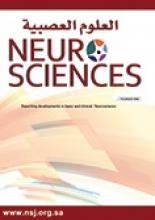Review ArticleReview Article
Open Access
Essentials of research methods in neurosurgery and allied sciences for research, appraisal and application of scientific information to patient care (Part I)
Ignatius N. Esene, Amr M. El-Shehaby and Saleh S. Baeesa
Neurosciences Journal April 2016, 21 (2) 97-107; DOI: https://doi.org/10.17712/nsj.2016.2.20150552
Ignatius N. Esene
From the Department of Neurosurgery (Esene, El-Shehaby), Ain Shams University, the Gamma Knife Center (Esene, El-Shehaby), Nasser Institute, Cairo, Egypt, and the Division of Neurosurgery (Baeesa), Department of Surgery, Faculty of Medicine, King Abdulaziz University, Jeddah, Kingdom of Saudi Arabia
MD, MPHAmr M. El-Shehaby
From the Department of Neurosurgery (Esene, El-Shehaby), Ain Shams University, the Gamma Knife Center (Esene, El-Shehaby), Nasser Institute, Cairo, Egypt, and the Division of Neurosurgery (Baeesa), Department of Surgery, Faculty of Medicine, King Abdulaziz University, Jeddah, Kingdom of Saudi Arabia
MD, PhDSaleh S. Baeesa
From the Department of Neurosurgery (Esene, El-Shehaby), Ain Shams University, the Gamma Knife Center (Esene, El-Shehaby), Nasser Institute, Cairo, Egypt, and the Division of Neurosurgery (Baeesa), Department of Surgery, Faculty of Medicine, King Abdulaziz University, Jeddah, Kingdom of Saudi Arabia
MBChB, FRCSC
References
- ↵
- Vandenbroucke JP
- ↵
- Sandu N,
- Sadr-Eshkevari P,
- Schaller BJ
- ↵
- Grimes DA,
- Schulz KF
- ↵
- Bhandari M,
- Joensson A
- ↵
- Egger M,
- Smith GD,
- Sterne JA
- ↵
- Esene IN,
- Ngu J,
- El Zoghby M,
- Solaroglu I,
- Sikod AM,
- Kotb A,
- et al.
- ↵
- Esene IN,
- Kotb A,
- ElHusseiny H
- Ng TT,
- McGory ML,
- Ko CY,
- Maggard MA
- ↵
- Klimo P Jr.,
- Thompson CJ,
- Ragel BT,
- Boop FA
- ↵
- Haines SJ
- ↵
- Schöller K,
- Licht S,
- Tonn JC,
- Uhl E
- ↵
- Esene IN,
- Kotb A,
- ElHusseiny H
- ↵
- Nesvick CL,
- Thompson CJ,
- Boop FA,
- Klimo P Jr.
- ↵
- Kiehna EN,
- Starke RM,
- Pouratian N,
- Dumont AS
- ↵
- Glasser SP
- Gorelick PB,
- Alter M
- Rothman KJ,
- Greenland S,
- Lash TL
- Molgaard CA
- Nelson LM,
- Tanner CM,
- Eeden SVD,
- McGuire VM
- Grobbee DE,
- Hoes AW
- Zaletel-Kragelj L,
- Botikov J
- Bonita R,
- Beaglehole O,
- Kjellstrom T
- Haynes RB,
- Sackett DL,
- Guyatt GH,
- Tugwell P
- ↵
- Bland M
- ↵
- Fletcher RH,
- Fletcher SW
- Gail MH,
- Benichou J
- ↵
- Feigin VL,
- Bennett DA
- ↵
- Winn HR
- Garton H,
- Barker FG II.,
- Haine SJ
- ↵
- Gail MH,
- Benichou J
- ↵
- Hennekens CH,
- Buring JE,
- Mayrent SL
- ↵
- Dekkers OM,
- Egger M,
- Altman DG,
- Vandenbroucke JP
- ↵
- Grimes DA,
- Schulz KF
- ↵
- Leucht S,
- Kissling W,
- Davis JM
- ↵
- Haines SJ,
- Walters BC
- ↵
- Wupperman R,
- Davis R,
- Obremskey WT
- Yarascavitch BA,
- Chuback JE,
- Almenawer SA,
- Reddy K,
- Bhandari M
- ↵
- Medina JM,
- McKeon PO,
- Hertel J
- ↵
- Burls A
- ↵
- Haines SJ
- Vandenbroucke JP
- ↵
- Lo BW,
- Macdonald RL,
- Baker A,
- Levine MA
- Shamim MS,
- Enam SA,
- Qidwai U
- ↵
- Godil SS,
- Shamim MS,
- Enam SA,
- Qidwai U
- ↵
- Glaser AN
- ↵
- Grant WB
- ↵
- Grant WB
- ↵
- Petrie A
In this issue
Essentials of research methods in neurosurgery and allied sciences for research, appraisal and application of scientific information to patient care (Part I)
Ignatius N. Esene, Amr M. El-Shehaby, Saleh S. Baeesa
Neurosciences Journal Apr 2016, 21 (2) 97-107; DOI: 10.17712/nsj.2016.2.20150552
Jump to section
Related Articles
- No related articles found.
Cited By...
- No citing articles found.





